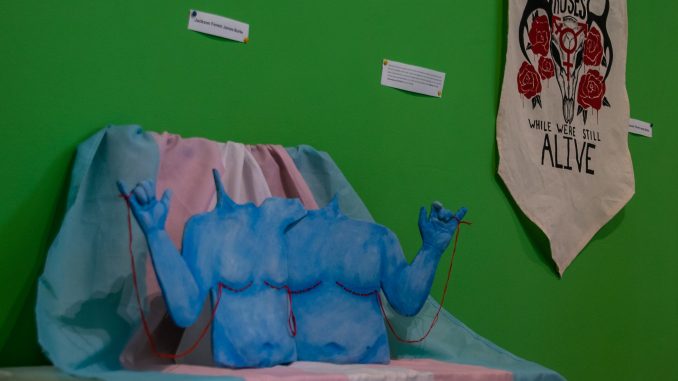
Having grown up without any transgender role models, Jackson Burke wants to make sure transgender people can see themselves, and their experiences, represented in art and everyday life.
“When I am being out and proud as a trans person, there are trans people who are closeted who will see my experience, see that I am happy and follow in my footsteps behind me,” said Burke, a junior ceramics major and president of Students for Trans Awareness and Rights, an organization advocating on behalf of trasngender students. “They will feel empowered not only to be out and proud as a trans person like I am but also to know that they can make the same art too.”
STAR invited transgender students to display their art in the Green Hallway in the Presser Hall from March 29 to April 2, for their first Transgender Day of Visibility Art Show. Roughly 20 people attended the main event on March 31 — Transgender Day of Visibility — which included a speech by Kendall Stephens, a transgender activist.
“Trans people, they struggle with employment, they struggle with housing,” Burke said. “Giving them a space to exist that not only accepts the fact that they’re trans but celebrates the fact that they’re trans is important.”
Artists submitted their artwork through a link on STAR’s Instagram page. All 27 submissions were accepted because Burke thought they were high quality and believes all transgender artists should be celebrated.
Eitan Runyan made four pieces for the art show — a kippah, tiara, necklace and Hebrew calligraphy — to represent the intersection of his gender identity and Judaism.
He was inspired by his grandmother, who used painting to express her Jewish faith, and wants to make transgender people with intersectional identities feel recgonized, said Runyan, a freshman anthropology major.
Art has also helped Runyan cope with feelings of social isolation from being an outsider in both transgender and Jewish communities, Runyan said.
“I grew up in a more religious community, and though I never experienced transphobia from them, I felt I wasn’t well represented,” Runyan said. “Then, coming to the more non-Jewish world, I felt I wasn’t being understood or represented as a Jewish person.”
Quincy Hukow submitted digital prints of transgender bodies in sexual poses with abstract and supernatural elements, like chicken heads and floating steaks, as a commentary on the fetishization and objectification she has experienced.
She hopes her art helps normalize transgender bodies, said Hukow, an undeclared freshman.
“I hope that they can look at my art, not be like, ‘That’s weird, that’s a weird thing to show,’ like a man with a vagina or scars, or women with a penis or breast, or all that stuff,” Hukow said.
Though Transgender Day of Visibility is about raising awareness, it is important to honor transgender people who are not visible, said Stephens, a senior public health and social work major, during her speech.
Transgender people are often silenced in society but art can share their experiences, increasing visibility and respect for transgender people, Stephens said.
“There are so many people who are trans-identified that are in fear for their lives to the point where they cannot manifest their visibility, and I want to show some honor to those people as well because they matter,” she said.


Be the first to comment